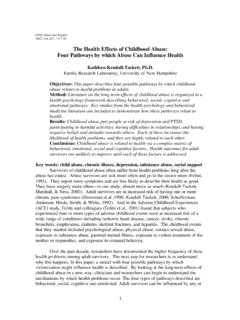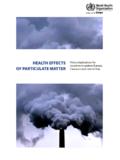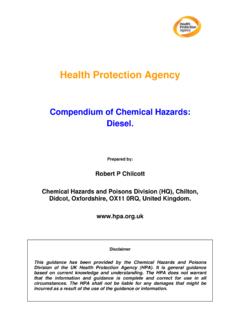Transcription of Health Effects of Black Carbon - WHO/Europe
1 %. 100. 50. 0. 0,5 2,5 3,5. Health Effects OF. Black Carbon . Health Effects of Black Carbon By: Nicole AH Janssen, Miriam E Gerlofs-Nijland, Timo Lanki, Raimo O Salonen, Flemming Cassee, Gerard Hoek, Paul Fischer, Bert Brunekreef, Michal Krzyzanowski The WHO European Centre for Environment and Health , Bonn, WHO Regional Office for Europe, coordinated the development of this publication. ABSTRACT. This report presents the results of a systematic review of evidence of the Health Effects of Black Carbon (BC). Short-term epidemiological studies provide sufficient evidence of an association of daily variations in BC concentrations with short-term changes in Health (all-cause and cardiovascular mortality, and cardiopulmonary hospital admissions).
2 Cohort studies provide sufficient evidence of associations of all- cause and cardiopulmonary mortality with long-term average BC exposure. Studies of short-term Health Effects suggest that BC is a better indicator of harmful particulate substances from combustion sources (especially traffic) than undifferentiated particulate matter (PM) mass, but the evidence for the relative strength of association from long-term studies is inconclusive. The review of the results of all available toxicological studies suggested that BC may not be a major directly toxic component of fine PM, but it may operate as a universal carrier of a wide variety of chemicals of varying toxicity to the lungs, the body's major defence cells and possibly the systemic blood circulation.
3 A reduction in exposure to PM containing BC and other combustion-related PM material for which BC is an indirect indicator should lead to a reduction in the Health Effects associated with PM. Keywords AIR POLLUTION adverse Effects SOOT toxicity INHALATION EXPOSURE adverse Effects PARTICULATE MATTER analysis RISK ASSESSMENT. ISBN: 978 92 890 0265 3. Address requests about publications of the WHO Regional Office for Europe to: Publications WHO Regional Office for Europe Scherfigsvej 8. DK 2100 Copenhagen , Denmark Alternatively, complete an online request form for documentation, Health information, or for permission to quote or translate, on the Regional Office web site ( ). World Health Organization 2012. All rights reserved.
4 The Regional Office for Europe of the World Health Organization welcomes requests for permission to reproduce or translate its publications, in part or in full. The designations employed and the presentation of the material in this publication do not imply the expression of any opinion whatsoever on the part of the World Health Organization concerning the legal status of any country, territory, city or area or of its authorities, or concerning the delimitation of its frontiers or boundaries. Dotted lines on maps represent approximate border lines for which there may not yet be full agreement. The mention of specific companies or of certain manufacturers' products does not imply that they are endorsed or recommended by the World Health Organization in preference to others of a similar nature that are not mentioned.
5 Errors and omissions excepted, the names of proprietary products are distinguished by initial capital letters. All reasonable precautions have been taken by the World Health Organization to verify the information contained in this publication. However, the published material is being distributed without warranty of any kind, either express or implied. The responsibility for the interpretation and use of the material lies with the reader. In no event shall the World Health Organization be liable for damages arising from its use. The views expressed by authors, editors, or expert groups do not necessarily represent the decisions or the stated policy of the World Health Organization. Edited by: Rosemary Bohr. Cover design: Dagmar Bengs.
6 Pictures: axepe, Imaginis, Ingo Bartussek, Jeanette Dietl, Kalle Kolodziej, mozZz, think4photop ( ). Printed by: WarlichDruck RheinAhr GmbH. CONTENTS. Page iv Abbreviations .. v Executive summary .. vii Introduction .. 1. References .. 3. 1. Metrics used to estimate the exposure to BC in Health studies: strengths and weaknesses .. 4. Introduction .. 4. Measurement methods of the dark component of PM .. 5. Comparison of the optical measurement methods with each other and with more sophisticated methods .. 6. Conclusions .. 10. References .. 11. 2. Assessment of exposure to BC in epidemiological studies .. 13. Short-term exposures .. 13. Long-term exposures .. 16. Conclusions .. 19. References .. 20. 3. Effects of BC exposure observed in epidemiological studies.
7 23. Results .. 24. Discussion .. 30. References .. 33. 4. Evidence from toxicology, including human clinical studies .. 37. Introduction .. 37. Adverse Health Effects of BC in the controlled human exposure experiments .. 41. Mechanisms of toxicity .. 45. Conclusions .. 46. References .. 46. Annex 1. Literature search criteria .. 51. Annex 2. Contributors to the 55. Annex 3. Supplementary material to the review of epidemiological studies .. 57. Health Effects of Black Carbon page iv Acknowledgements This report was prepared by the Joint World Health Organization (WHO)/Convention Task Force on Health Aspects of Air Pollution according to the Memorandum of Understanding between the United Nations Economic Commission for Europe and the WHO Regional Office for Europe.
8 The Regional Office thanks the Swiss Federal Office for the Environment for its financial support of the work of the Task Force. The Task Force on Health work is coordinated by the WHO European Centre for Environment and Health , Bonn. Convention on Long-range Transboundary Air Pollution Health Effects of Black Carbon page v Abbreviations Abs absorbance BC Black Carbon BCP Black Carbon particles BS Black smoke CVD cardiovascular disease DE diesel engine exhaust EC elemental Carbon IQR inter-quartile range NIOSH National Institute for Occupational Safety and Health OC organic Carbon PAH polycyclic aromatic hydrocarbons PM particulate matter POM particulate organic matter RSS rice-straw smoke RR relative risk TOR thermal optical reflectance TOT thermal optical transmittance UFP ultrafine particles Health Effects of Black Carbon page vii Executive summary1.
9 Following decision 2010/2 of the Executive Body for the Convention on Long-range Transboundary Air Pollution ( , para 8(b)(i)), the Task Force on Health Aspects of Air Pollution working under the Convention conducted an assessment of the Health Effects of Black Carbon (BC) as a component of fine particulate matter ( ). The Task Force's discussion focused on formulating the conclusions presented below, on the basis of the working papers prepared for it and comments received from external reviewers. BC is an operationally defined term which describes Carbon as measured by light absorption. As such, it is not the same as elemental Carbon (EC), which is usually monitored with thermal- optical methods. Current measurement methods for BC and EC need to be standardized so as to facilitate comparison between the results of various studies.
10 The main sources of BC are combustion engines (especially diesel), residential burning of wood and coal, power stations using heavy oil or coal, field burning of agricultural wastes, as well as forest and vegetation fires. Consequently, BC is a universal indicator of a variable mixture of particulate material from a large variety of combustion sources and, when measured in the atmosphere, it is always associated with other substances from combustion sources, such as organic compounds. The spatial variation of BC is greater than that of Although, in general, ambient measurements or model estimates of BC reflect personal exposures reasonably well and with similar precision as for , the differences in exposure assessment errors may vary between studies and possibly affect estimates of risk.















